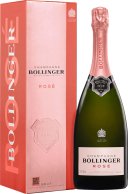Any price
Amisfield Pinot Noir Rose
Rose petals, watermelon and summer berries on the nose. The palate is silky with berry, red fruit flavours and a refreshingly soft and creamy with a dry finish.
Bollinger Rose Non-Vintage
Red berries, hints of red currant, cherry and wild strawberry with a spicy touch, not unlike Special Cuvée. A subtle combination of structure, length and vivacity, with a tannic finish due to the adjunction of red wine; bubbles as fine as velvet ; flavours of wild berries.
Babo Rosato
Byott Cotes De Provence Rose
APPEARANCE: Pale and pretty in crystal-clear pink with orange undertones. AROMA: The nose is delicate and fruity with notes of white peach and apricot mixed with passion fruit and mango. PALATE: The taste is full, fresh and crisp with echoes of the fruity aroma amplified by citrus zest and sweet spices (cinnamon and cardamom). In 1896 Marcel Ott of Alsace found an estate which inspired him, Château de Selle in Tarandeau, Provence, where once olives, lavender and mulberries grew. Enjoying a unique microclimate, the wines are delicate and elegant with great depth. In the 1930s, Marcel Ott fell in love with the very old Clos Mireille, overlooking the sea at La Londe Les Maures, near Brégançon. The vines soon started producing distinctive yet subtle wines. Château Romassan in Bandol was acquired by the Ott family in 1956 and following years of terracing and replanting, produces robust, harmonious and long lived wines. Cur de Grain represents wine-making genius, and today the distinctive bottle evokes the memory of the elegant amphora of centuries past. Today, 120 years later, cousins Jean-François and Christian Ott dedicate their lives to their ancestors love for Provence. In 2004, Domaines Ott* joined Louis Roederer and its fabulous selection of wine craftsmen.
Minuty Prestige Rosé
Château d'Esclans Garrus Rosé
Sticks Rosé
Vins Bréban Villa Aix AOP Coteaux d'Aix-en-Provence
Standard to a Provence style rosé, Maison Breban Villa Aix AOP Coteaux d'Aix-en-Provence is produced from a blend of Grenache, Cinsault, and Syrah. Empowering the wine while young with aromas of red berries the Grenache also provides its body, power, and magnitude. The Cinsault provides the freshness, delicacy and fruity touch, while also conveying other nuanced qualities from the other varietals in the blend. The Villa Aix rosé wine goes well with charcuterie, grilled fish, and many white meats. Best to be served at a temperature of 8° to 10°C.
Excuse My French Rose
Excuse My French Rose is a classic french rosé; pale and dry with flavours of red summer berries, a soft & textural mouthfeel, and a crisp elegant finish. Direct pressing. Important racking of the must in order to obtain very clear juice. The juice is then vinified like a white wine and fermented at low temperatures (15°C). No malolactic fermentation to retain freshness.
Saint Max Provence Rose
Saint Max Rosé is named after Saint Maximin d'Aix, the legendary first bishop of Aix-en-Provence from the 1st century AD. According to the legend, he was the steward of the family of Mary Magdalene and her brother Lazarus and sister Mary at Bethany. Around the year AD43 he fled the Holy Land with them in a rudderless and sail-less boat. Miraculously they survived to land at Saintes-Maries-de-la-Mer, in the Camargue near Arles. After landing in the Camargue, Mary Magdalene and Maximin began to convert the local people in Marseille and Aix-en-Provence. came to Marseille and converted the local people. Later in life, according to the founding legend, Mary Magdalene retired to a cave in the Sainte-Baume mountains until, on her last day she came to Maximin so that he could give her communion and arrange her burial. Her sarcophagus is now at the Basilica of St Mary Magdalene at Saint-Maximin-la-Sainte-Baume, the town named after Maximin. Today Saint Maximin is the patron saint of the diocese of Aix. The vineyards are located in the inner valley of the Cuers plain, on the foothills of the Massif des Maures, and on the arçois inland country at the foot of these same mountains. Saint Max Provence Rose 2020 is whole-bunch pressed with short skin contact to ensure a pale and bright hue as well as an intense aromatic expression. In order to preserve the natural acidity and freshness of the wine’s aromas, the malolactic fermentation is not processed. Aging on fine lees in tanks for 3 months before early bottling. Pale pink colour, intense citrusy grapefruit and peach notes and a delicate, intense mid-palate. Ideal as an aperitif or with light seafood dishes or fresh prawns.










